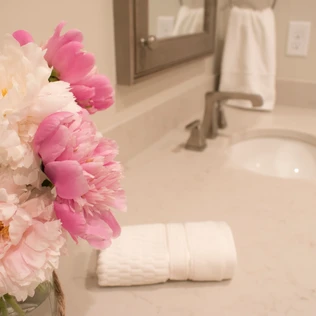 Last week, Jeff Kaper walked you through deciding if an interior design project is the right thing to do. Will it return the investment when you sell the house? Is it the right time? Do you want to take it on right now?
Last week, Jeff Kaper walked you through deciding if an interior design project is the right thing to do. Will it return the investment when you sell the house? Is it the right time? Do you want to take it on right now?
Embarking on an interior design project is exciting! Who doesn’t want to transform their living space into a haven of style and comfort? However, as Jeff pointed out, it’s essential to understand interior design costs clearly before you begin.
What to Think About Before You Hire a Designer
Before diving into interior design costs, it’s crucial to know your goals, what budget you have to work with, and to do your due diligence. Too often, we get one referral from a friend and hire them without doing any due diligence. That should be on your list simply because your style may not match theirs, no matter how much your friends raved about them.
Start by clarifying your design goals and objectives. What do you want to achieve with your interior design project? Define your style preferences, functional needs, and any design elements you wish to incorporate. Save photos to a Pinterest board or on a bulletin board at home. This will help your designer understand what you are naturally attracted to so they can design with you in mind.
Next, establish a budget. Determine how much you have to invest in the project and how you will pay for it.
From there, it’s time to do your due diligence. Create a short list of designers and research their portfolio, reviews, and qualifications to ensure they align with your vision and budget expectations. Call their former clients and ask what they liked—and didn’t like—about working with them.
Then, interview each of them and clearly communicate your goals, budget, and design priorities.
How to Budget Your Interior Design Project
Now that you’ve considered your project’s objectives and set a realistic budget, let’s delve into how to budget effectively for your interior design project.
First, prioritize your needs. Identify what you want and how long you expect it to take. For instance, are you redesigning your entire home or just one room? If so, will you do one room at a time and spread the project out over several months, or will you attempt to do it all simultaneously? These expectations are important for your designer to know and to help you prioritize and budget.
Next, factor in the cost of materials, including furniture, fixtures, textiles, flooring, and decorative elements. Consider labor and installation costs, especially if your project involves significant renovations or custom-built elements. And include interior design fees, including a flat fee, hourly rate, or a percentage of the total project cost. Ensure you understand these fees and budget for them accordingly. Then, set aside a contingency fund for unexpected expenses during the project. A common rule of thumb is to allocate 10-20% of your budget for contingencies.
Hidden Costs to Expect
As with anything house-related, these projects often bring unforeseen expenses. Here are some hidden costs to be aware of:
- If you do renovations as part of your project, they may reveal structural problems that must be addressed before proceeding with the design. These repairs can add unexpected costs to your project.
- Changes or modifications to the original design plan can lead to additional expenses, often requiring materials, labor, or timeline adjustments.
- Delays in material deliveries, labor availability, or unforeseen issues can extend your project’s timeline, potentially increasing temporary living arrangements or storage costs.
- Depending on the scope of your project, you may need permits or have to comply with building regulations. Permit fees and compliance costs can add to your budget.
- Shipping and handling fees can quickly increase if you order furniture or decor items from different locations. Be sure to include these costs in your budget.
- You may incorporate additional design services, such as custom-made furniture or specialty finishes, which can also increase your project costs.
How Long to Expect the Project to Last
Understanding the timeline of your interior design project is essential for planning and managing your expectations.
The initial planning phase, including goal setting, research, and designer selection, can take several weeks to a few months, depending on the complexity of your project—and how much time you’re willing to commit.
Once the design process begins, it typically takes two to four months to finalize design concepts, select materials, and create detailed plans. Then, implementation, which includes ordering materials, coordinating tradespeople, and overseeing construction or installation, can take three to six months or longer, depending on the project’s scope. The final phase involves adding finishing touches, styling, and ensuring all design elements are in place. This phase typically takes a few weeks to a month.
An interior design project can take anywhere from six months to more than a year, depending on its complexity and any unforeseen delays.
Interior Design Done Well
Interior design is a rewarding journey that can breathe new life into your home. You can confidently navigate your project’s financial aspects by carefully considering your design goals, setting a realistic budget, and accounting for potential hidden costs.
A well-executed interior design project enhances the aesthetics of your home, improves its functionality, and excites you to host friends and family for a dinner party, a game night, or the holidays.



